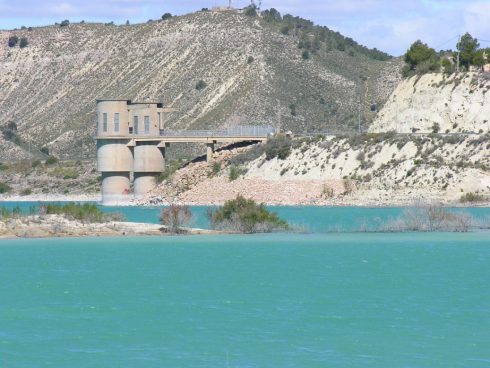
BOB MADDOX goes gunning for the greenhouses that cover Spain’s southern coast. But El Gringo Maddox, who normally shoots from the lip when plastic is concerned, finds that those invernaderos could be the key in the fight against global warming
WHEN Sergio Leone wanted a desert landscape to provide the backdrop to his iconic 1966 paella western, The Good, The Bad and The Ugly, he came to Almeria’s Tabernas desert. It was out across the wild wastes of these badlands that the good Clint Eastwood traded bullets with the bad Lee Van Cleef and that deliciously ugly bandito, Eli Wallach.
In the intervening 42 years, the province of Almeria has been home to dramatic and sweeping changes. Of these, only one has been so rapid, so extensive and so uncontrolled that it has the dubious honour of holding a world record and being the only manufactured object clearly visible from Earth’s orbit. When our three titans clashed in Tabernas, there were around 10 hectares of plastic greenhouses (invernaderos) in the province of Almeria. Today, that figure is closer to 26,000 hectares… and growing. If Clint were riding out to meet his two adversaries today, his trademark poncho would almost certainly be made from plastic.
But is the story of the invernadero all Bad and Ugly? Is there some Good out there somewhere? So, straighten your poncho, wrinkle up those eyes against the glare, stick a fresh cheroot between those wind-burned lips and ride with me out into that desert of plastic. Who knows what we might find.
The Good
The older inhabitants of Yegen, Valor and Mecina Bombaron – those fortunate, well-watered villages of La Alpujarra, have harrowing tales to tell of times when refugees visited them. They came not from some war-zone, but from the drought stricken areas around El Ejido and the Campo de Dalias. They were fleeing the spectre of starvation; seeking food to keep their families alive.
In the space of considerably less than one human lifetime, however, the Third Horseman of the Apocalypse has been banished from these arid pains and Almeria has been transformed into what has been called The Garden of Europe and the richest province in Spain. All thanks to those sprawling hectares of plastic.
In December 2006, all that plastic prosperity was threatened when it was revealed that Almeria’s plasticulturalists had been rather naughty and sprayed their peppers with a pesticide called Irofem Fosmetyl – a banned substance in the European Union. Major supermarkets in Germany, the Netherlands, France and the United Kingdom removed Almerian produce from their shelves and the economy of the entire province was threatened with collapse as further orders were suspended.
But, in the best traditions of the old Wild West, the cavalry came riding over the hill just in the nick of time in the unlikely form of Amblyseuis swirskii. This is a particularly greedy little bug with an appetite for whitefly, thrips and the other little pests that infest and ruin the pepper crop. Amblyseuis and his pals formed the basis of a new approach to the problem of pest control – IPM, or Integrated Pest Management.
In the wake of the poison disaster, the spread of IPM – which uses natural biological controls alongside tradition chemical pesticides – has been rapid.
Melvyn Fidgett, that fabulously named manager of Syngenta Bioline, a promoter of IPM, reports that 90 per cent of Almeria’s pepper growers have switched to the new method and projections are that around 15,000 hectares of greenhouses could be using biological controls within five years. Certainly, the advertising hoardings around El Ejido reflect a change, showing images of beneficial bugs and bumble bees. As little as a year ago, they were advertising poison.
And less poison on the crops, of course, means less in the already massively burdened soils and groundwater of Almeria and the coastal waters of the Mediterranean.
Verdict? Holster that pistol stranger and touch the rim of that Stetson in a proper Western salute. There’s Good out in them thar greenhouses.
The Bad
Unfortunately, no matter how many bugs we throw at the problem, there is one essential element of plant growth for which no substitute can ever exist… water.
With Almeria’s salad crops consisting of around 95 per cent water, every thousand tonnes of food exported from The Garden of Europe, takes 950 tonnes of precious water with it. Gone forever. Almeria, the doughtiest place in Europe, continues to export massive volumes of its irreplaceable groundwater. As more illegal wells are dug and groundwater levels continue to fall, the Mediterranean creeps in to poison the rest with its salt.
Surely, through this one simple, inescapable truth alone, the industry which catapulted Almeria from poverty to riches in such a short time, will bring about its own inevitable collapse. When the water finally runs out, there will be no cavalry to ride over the hill. What then for Almeria? Economic overdependence has always been a dangerous game.
Ironically, as well as leading to a shortage of water, invernaderos have been identified as a prime agent in its excess. A Guardia Civil report of October 2007, highlights nine municipalities as being at risk from catastrophic flooding as a result of land being covered with impermeable plastic.
With scant health or environmental legislation in place to control plasticultura, the way is open for the dumping of pesticides and the burning of dioxin laden waste plastic. With an estimated 30,000 tonnes of plastic and organic waste involved each year, there are serious implications for both the environment and the health of the 200,000 people estimated to live in the dense plastic wilderness around El Ejido and the Campo de Dalias.
Verdict? Hitch back that poncho and clear your holster for action.
The Ugly
There are some things that need to be seen from above in order to appreciate their true scale and character. Such things as the fantastic giant art works and patterns of Peru’s Plains of Nazca; the great neolithic complex of stone circles and burial chambers around Avebury, Wiltshire; the Great Wall of China; Australia’s Great Barrier Reef, David Beckham’s salary and perhaps even our wonderful planet itself. To these wonders I here respectfully suggest that we add another – the invernaderos of Almeria.
In a mere 40 years, these have grown to fill every available space from Almeria city to the east and out across the coastal plain well beyond Adra. The Campo de Dalias and the town of El Ejido hold the record for the highest density of plastic greenhouses in the world. On a national scale only China, with its philosophy of unrestrained growth at any cost, has more greenhouses than Spain – and by far the greatest concentration of these are right here in Almeria and Granada.
Of the wonders listed above, only the Great Barrier Reef is visible from Earth orbit, where the naked eye picks it out as a delicate curving line of silver and turquoise flecks. The plastic greenhouses of Almeria, on the other hand, are unmistakable and obvious – an insistent silver semaphore consisting of thousands of reflective plastic sheets which make this relatively tiny area the single most visible man-made object on the planet.
Moving in a little closer, the approach to Almeria airport offers the first-time visitor a fine jets-eye view of… well, what exactly? The first question on the lips of every visiting friend I have met at Almeria airport has been: “What on earth is all that stuff we saw out the window on the way in?”
Guesses have ranged from artificial lakes or fish farms, through giant solar power developments to some strange trick of light across the Mediterranean itself. One first-timer endearingly remarked: “What a beautiful place. I never knew the Mediterranean came right up to the foot of the mountains like that!”
No one has ever guessed the Ugly truth of the matter. A one-minute drive from the airport soon disabuses them as we plunge into a horizonless wasteland of ragged, sagging greenhouses, studded with heaps of discarded plastic containers and drums, strewn with rotting tomatoes and other organic waste and haunted by itinerant workers with hopeless faces.
My favoured route is to follow the Autovia del Mediterraneo (what a heartbreakingly beautiful name) westwards as far as La Rabita, before turning north through Albuñol and over the Contraviesa mountains. Admittedly, this does add perhaps 30 minutes to the journey from Almeria to Yegen, but it has the outstanding advantage that it exposes my visitors to a fair cross-section of the full visual horror of the situation.
I always feel that a particularly fetching part of the experience is that first sight of the great rolls and coils of last year’s discarded plastic roofing, spilling like giants intestines down the hillsides and into the rambla just outside Albuñol. Beautiful. When was the last time you saw that on a postcard from Andalucia?
Verdict? Go for your gun.
Well, there you have it. And maybe it is worth remembering that in Leone’s final cinematic shoot-out, Good – although out-gunned two to one – triumphs over Bad and Ugly. The odds against the same happening among the invernaderos of Almeria are I fear, rather higher. But before we ride off into the sunset, here is one more little snippet for you.
It seems that plastic greenhouses may actually be combating that favourite environmental demon, global warming. According to Pedro Campra of the University of Almeria, those 26,000 hectares of plastic have a huge albedo! Now I always wanted a huge albedo myself, thinking it was something to do with sex-drive, but apparently it is a measure of how much light a surface reflects.
With those greenhouses acting as a giant mirror, air temperatures in the Greenhouse Zone have fallen by 0.3 degrees Celsius per decade since 1983, instead of rising by 0.5C, as they have in the rest of Spain. So maybe just dressing the world in a planetary plastic poncho of greenhouses will be the answer to all of our problems.
I just hope you like peppers.







Thanks, a really interesting article – and good to see there are some positive aspects of what my heart tells me is just downright ugly!
Plastic coverings do more to harm the environment. The stuff looks awful, blows about in the wind and litters the entire area. It should be banned.
Interesting article on how the Spanish still operate a slavery practice under those plastic ‘greenhouses’. Sshhhh.
http://www.guardian.co.uk/environment/video/2011/feb/07/food-spain-migrants